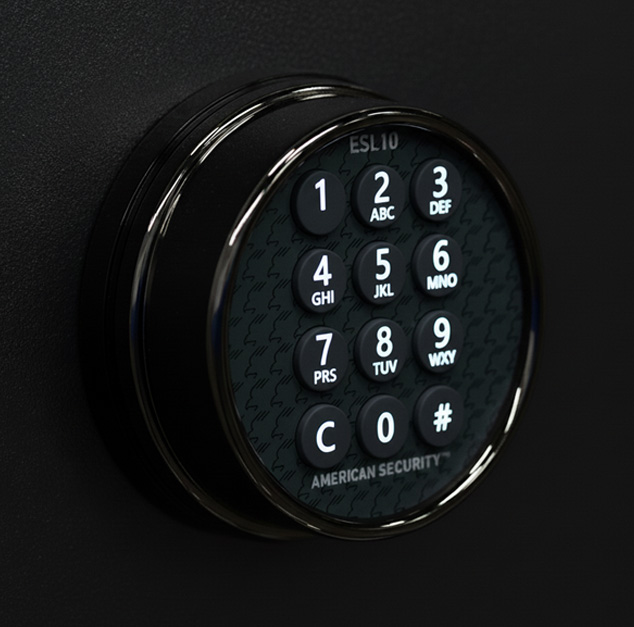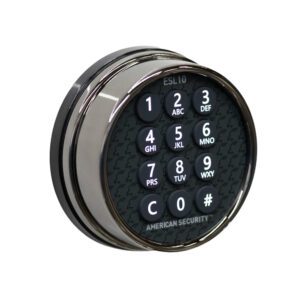After purchasing a safe, it’s important to stay on top of its maintenance and upkeep to protect your investment. By not doing so, you risk negatively impacting the lifespan of your safe. A large part of this maintenance includes the safe lock. Many models come with electronic locks, and believe it or not, they require some care and maintenance to ensure they last over the years.
Let’s jump into some easy ways you can maintain your electronic safe lock.
The Importance of Proactive Electronic Safe Lock Maintenance
Regular upkeep protects your investment, because after all, safes cost a significant amount, and you don’t want it to go to waste. Plus, you want to make sure your valuables are properly secured and protected from forced entry or the elements.
By not maintaining your electronic lock, you risk the technology becoming unresponsive or the battery compartment inside becoming corroded over time. Depending on where you’re storing the safe, environmental factors can expedite and perpetuate a lock’s poor performance if it goes unaddressed.
All that to say, electronic locks require consistent monitoring and maintenance to prevent these issues from significantly impacting your safe as a whole.
Battery Care for an Electronic Safe Lock
First and foremost, since electronic locks run on batteries, it’s important to pay close attention to the upkeep for this part of the safe’s security system. We recommend using Duracell 9-volt alkaline batteries and replacing them once a year or when you hear a long ring tone and the keypad flashes rapidly for about 2 seconds. If the battery dies completely, you can still access your safe, but only after the battery has been replaced. Staying proactive with battery replacements helps you avoid that situation altogether.
Whenever you change the batteries, take a moment to inspect the compartment for signs of corrosion, dirt, or damage. Clean the area thoroughly before inserting the new batteries to maintain a solid connection. Additionally, store spare batteries in a cool, dry place to prevent corrosion and extend their shelf life.
Maintaining the Electronic Keypad
Keeping your electronic keypad clean and well-maintained helps extend its lifespan and ensures reliable performance. Use a soft microfiber cloth with a mild, non-abrasive cleaner to wipe down the keypad. Avoid harsh chemicals, abrasive materials, or excessive moisture, as these can damage the surface or interfere with the lock’s functionality.
Over time, frequent use can cause wear on specific buttons, making it easier for others to guess your code. To reduce this risk, periodically update your combination. If you notice significant wear, fading, or damage to the keypad, contact a qualified technician to inspect or replace it.
Environmental factors like high humidity or extreme heat can also affect the lock’s performance over the years. If you see signs of moisture buildup or heat-related damage, consider relocating the safe to a more stable environment to protect both the lock and its contents.
How to Troubleshoot & When to Call a Technician
Depending on the issue, you can troubleshoot electronic lock problems on your own but there are circumstances where you may need to call in a technician. We’re going to go over some of these instances and when it’s the appropriate time to reach out to a professional.
Lock Not Responding
Check the battery connections to the electronic lock and the cleanliness of the keypad. It might be something minor getting in your way, but if you find some major damage or corrosion, a new lock might be needed.
Repetitive Code Errors
When in doubt, reset the lock and/or verify that you’re inputting the correct code. If you need help with your American Security lock, we offer online manuals for you to easily conduct simple troubleshooting to get your lock back in working order.
Weak Keypad Responses/Noises
This one is rather simple and often just means you need to replace your battery.
When to Contact a Professional
Here are a few examples of when we highly recommend reaching out to a technician to help resolve the lock issue.
- Lock is unresponsive after battery replacement
- Safe fails to open even with the correct code
- There’s visible corrosion and/or wiring issues
Those are just a few, but it’s beneficial to consult a technician whenever you’re unsure about a malfunction, as they can properly diagnose the issue and prevent you from voiding your warranty in any way.
Electronic Locks vs. Other Alternatives
If you are considering switching lock types or exploring different options, a mechanical lock is a dependable choice. American Security offers several mechanical lock models that deliver the same level of reliability as electronic locks. We also provide manuals and guides to help with setup and troubleshooting, making it easy to keep your lock working properly.
One option to approach with caution is the biometric lock. These locks often experience performance issues such as false readings or difficulty unlocking, which can make them less reliable than electronic or mechanical models.
No matter which type of lock you choose, regular maintenance is essential. Consistent care and monitoring will help keep your lock functioning smoothly and protect your valuables for years to come.
Keeping Your Lock Reliable and Secure
By following these simple maintenance practices, you can keep your electronic safe lock operating smoothly and extend its lifespan. Don’t ignore early signs of wear or malfunction. Addressing small issues quickly can help you avoid expensive repairs or the possibility of being locked out of your safe in the future.
If you own an American Security lock, refer to the user manual for model-specific guidance. If you encounter a more serious problem, contact a certified technician for professional support to keep your safe and everything inside protected.


